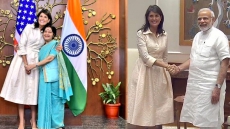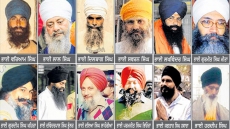Earlier this month, Commander Abhilash Tomy of the Navy put out a message on Facebook announcing his profile will go "silent" beginning July 1.
This is not one of the fashionable social media detox breaks for Mr Tomy, the only Indian to circumnavigate the world solo in a non-motorised boat without a stop.
The 2013 feat ensured that the 39-year-old Tomy gets invited to participate in the Golden Globe Race (GGR) involving a similar circumnavigation of the globe, starting from a French harbour on July 1.
What is more, Mr Tomy, a reconnaissance pilot with the Navy, is the only Indian among 18 skippers who will be at the start line.
The much talked about event was held first in 1968,which saw Englishman Sir Robin Knox-Johnston finish the race to become the first human to achieve the feat. But the race was never held again, probably due to the ill fate that the rest of the starters met with. Some sank, a few retired and a few others committed suicide midsea.
To commemorate the 50th anniversary, the same race is being organised again from July 1. But with a rider: the entire set-up will be the same as in 1968, even though technology has advanced by leaps.
Arguably, managing communication and navigation will be the biggest challenges. There will be no social media updates, while celestial movements and complex equations will be the only way to navigate the blue oceans.
"This event recreates, in the closest possible way, the magic of the original race. The emphasis is not on technology and its management, but on seamanship and a direct experience of the seas. This Spartan philosophy is in line with my own view that a lot can be achieved with very little,"Mr Tomy smiles.
Mr Tomy has named his boat, built at Goa's Aquarius Shipyard, as 'Thuriya' which in Sanskrit means the fourth state of the consciousness.
She is designed as a replica of Sir Robin's winning boat 'Suhaili', which had an India connection too: the boat was built in Colaba, and as a tributeto that Tomy has also built the 10-metre Thuriya as a replica.
Mr Tomy started preparations for the GGR in 2016, starting with the boat design,launched the boat a year later, practiced in the Indian waters and navigated through the complex Indian laws before sending her to a yard in the Netherlands for final fitments and sailed into Falmouth, England--the start point of the first GGR--earlier this month.
After weeklong celebrations and mandatory tests in Falmouth, all the skippers sailed with their boats to the French coast of Les Sables-d'Olonne, which is the start point for GGR 2018.
The skippers will sail South into the Atlantic Ocean to round the Cape of Good Hope in Africa, then head East to pass through the Cape Agulhas in Australia, cross then international dateline, and finally go round the Cape Horn in South America to re-enter the Atlantic Ocean for sailing back Northwards to the start point.
The 8-tonner Thuriya will brave the most demanding of the weather conditions and choppy waters which test even thousand-tonner-ships during the voyage. The skippers will have to be alert round the clock and also ensure their ship snare on the right direction.
There is no GPS-enabled navigation and the skippers will have to depend on celestial movements, which will be used to first plot their location on a map, and then chart the way ahead. On the return, all the notings will have to be shown to qualify as a finish.
Most of the equipment on board the Thuriya is imported, and special efforts have been taken to ensure it is a pre-1968 vintage stuff.
Mr Tomy has procured an anemometer to measure wind speeds from Bhavnagar in Gujarat, which was salvaged from a vessel that would have come to the nearby Alang for ship-breaking.
"It was a huge effort to build the boat and get it into this place," Tomy says.
Inside the Thuriya, the space is too little embodying the spirit of "less is more". Every inch is utilised for a specific purpose and objects like a plotting table for navigation, a micro-kitchen, a toilet and a small bed that he calls his 'winter palace' dominate. The 'summer palace' is out on the deck, Mr Tomy quips.
There are also the essentials like four gas cylinders,water and dry food to last the voyage. To be sure, the organisers have allowed the participants to carry satellite phones, but only for medical emergencies.
Sir Robin took as many as 312 days to complete the voyage, and Mr Tomy has set his eyes for 311 days, compared to the 150 days that he had taken in the 2013 voyage, the Sagarparikrama.
Mr Tomy acknowledges the Thuriya may not be the fastest of the boats, as it's modelled on an old design, but for him the GGR is more a race for survival than speed.
The challenges galore though, and the obsessive rules of the GGR such as the solo sailing, and insistence on not allowing any modern technologies may lead someone to call it a perilous voyage, but days before he leaves the shore and civilisation, Mr Tomy is nonchalant and full of wit.
"It is very difficult for me to sail with anyone. It is like taking your in-laws with you for honeymoon," he quips.
Meanwhile, the last few days have seen a flurry of activity on his Facebook profile, including a picture after having a haircut in the French port town.




